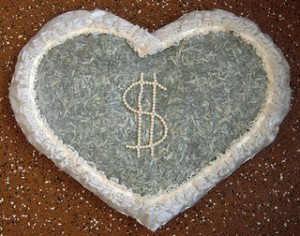Wouldn’t a pillow be nice between a rock and a hard place? Let me clarify, because the question is a little metaphorical.
When was the last time you were in a pinch financially? I don’t mean that your world was falling down around you. I mean you made a miscalculation on your budget or when you were balancing your checking account and you came up a little short.
In these moments, wouldn’t it be nice to have a financial cushion between you and the thing you need money for (call it “the rock and the hard place”)? Of course it would, but I’m not talking about your savings account. You probably already have one of those. Instead, I’m suggesting you keep a little extra money – a cushion – in your checking account at all times.
Why Not Just Link Checking and Savings?

Linking your checking and savings accounts is a cool tool. It allows your checking account to pull money from your savings account if you don’t have enough money to cover an expense. This is a really smart choice if all you look at is mathematics, but personal finance is a lot more than just finances. It’s about how we behave, too.
I’ve had my checking and savings accounts linked before. At first it worked great, but then my inner nature turned against me. I’d be looking at a potential purchase and think, “That’s not in the budget. But I do actually have the money…it’ll just pull automatically from the savings account.”
Additionally, some banks charge a fee to keep a link between the accounts, or to transfer money automatically. Keeping a cushion in your checking account solves both these problems. It might seem that having the money in your checking account will intensify the “the money is already there” problem, but I’ll show you below how the cushion actually circumnavigates that problem.
How to Set Up Your Financial Cushion
First you need to decide how much cushion to keep in your checking account. Remember, this isn’t about a hospital emergency. It’s about that moment when you budget for electricity (based on the last four months) and forgot the bill would double with the dropping temperatures. It’s for those (rare) times when you make a mistake that could overdraw your account.
Second, acknowledge that the money is in the account but don’t write it down. Don’t put it on the budget and don’t include it when you balance your account.
Third, forget about it as much as possible. You probably won’t forget about it entirely, but don’t keep reminding yourself it’s there. This is how you save yourself from spending it. If you’re looking at a purchase that isn’t on your budget and that money comes to mind, repeat: “That money doesn’t exist.” This works in this scenario but would fail with your savings account simply because it’s easier to “forget” about a small amount of money than it is a large one.
The last advantage is in the ratios. Let’s say you keep a $100 cushion in the checking account and $2,500 in the savings account. It’s a lot easier to spend $50 and have $2,450 left than it is to spend $50 and only have half your cushion to fall back on.
Maintaining Your Financial Cushion
Remember to check in every once in a while. Make sure the $100 (or however much you keep) is still there (that you haven’t miscalculated). And especially make sure to replenish the money if you ever have to use the cushion. There’s nothing worse than that sinking feeling of finding out your account is overdrawn when you thought you had a little extra.
We all make mistakes. But our mistakes don’t have to be fatal. Keep a cushion in your bank account. It’s just the wise thing to do.
Book Recommendations:
Get a Financial Life: Personal Finance In Your Twenties and Thirties – I bought an earlier version of this book way back in 1996. I had just gotten my first job and I was looking for information on how to manage money and to find out how much I could “afford” when buying a car and/or other expensive stuff. This book helped with all of that. It helped me understand the basics of personal finance, loans, insurance, 401(k), etc. There’s lots of good advice in there, so I’d certainly recommend it.
- Personal Finance For Dummies
- The Motley Fool Personal Finance Workbook : A Foolproof Guide to Organizing Your Cash and Building Wealth
Other Articles:
- College Savings Accounts
- Bad Financial Advice Abounds
- The Wealthy Buy Assets, the Poor Buy Liabilities, and the Middle Class Buy Liabilities Believing They Are Assets
- Explain Mutual Funds– Please?
- Buying Stocks and Bonds?
- Investing in a Mutual Fund
- Trading Online
Photo Credits: Lisa Yarost
